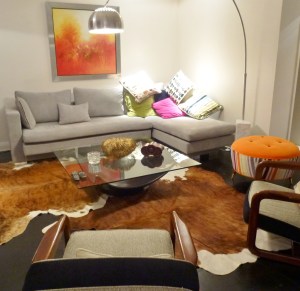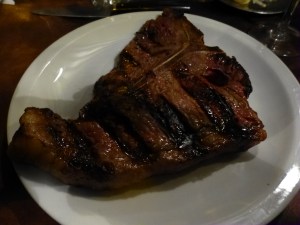The people of Argentina like cows. But unfortunately for the fifty five million cows that call Argentina home, they like their cows dead. Alive they cost money, dead they make money. Every imaginable part of the cow, and some that you might not care to imagine, is turned into food to fuel the people or accessories to decorate them.
Once the cow is slaughtered the first thing that is done is remove the hide. If it can be removed whole, then they quickly preserve it, lay it flat on the floor, call it a rug and sell it for a small fortune.
Or they can print it to look like a zebra, lay it on the floor, call it a zebra rug and sell it for even more .
If the animal was too small (aaawww!) and the skin looks more like a table cloth than a rug, that is not a problem
Skins that aren’t removed in one piece can be cut up and made into leather jackets, coats, dresses, shoes, handbags, belts and much more. Sometimes they do nothing to the hide, other than preserve it, leaving it in its natural state with all its hairs, which may be fine as a rug, but personally I worry about it as a piece of clothing. If I was wearing a jacket like that I would be concerned that a swarm of flies would mistake me for the real thing and buzz around my eyes. Or I might wander in front of a bull that would make the same mistake and an amorous adventure not of my choosing might follow
No, if I was going to wear a jacket made from a cow, I would want it to be of the fabulously smooth and soft leather variety which Argentina is renowned for. Then the only interaction would be with other humans who would want to touch me because my leather was so soft. That might lead to an amorous adventure entirely of my choosing .
Other parts of the cow’s body don’t go unnoticed by the local entrepreneurs either. They make fly swatters out of the tails, which are especially useful for those people wearing a jacket made out of the cow hide with the hairs still on it. But then if you were wearing that jacket and swishing that tail you could get into real trouble.
And then there are the bulls. There is one body part that the bull has, that can’t be found on a cow.
Dear readers, I know that you are now holding your breath to see what comes next. However, as you all know, Gordon is my editor and my censor. He corrects my spelling and grammar and tells me when I cannot say things that I want to say. Two services that I am in dire need of. When we learned of this next fact, he became extremely agitated, recognising that the telling of it would offer great temptations. However I am proud to say that as usual I have resisted all temptation, and shall relate the facts in a direct and simple manner.
The bull has a penis. And if you think that escapes the attention of Argentian traders, then you are very much mistaken. Somehow they have discovered that the penis of the bull is to dogs what catnip is to cats. I am not even going to linger on how that discovery was made, but suffice it to say that is absolutely true, and upmarket pet stores now sell chewies made out of a bull’s penis. Oh yes they do. And dogs cannot get enough of them. And the good thing for the industry is that one bull’s penis is actually rather large for the average dog, and so it is cut into two, doubling the profit and the number of obscenely happy dogs.
Once the animal has had all of its extremities removed and no further indignity can be inflicted on it, the Argentinians eat everything that is left.
Every inhabitant of this country eats on average a quarter of a pound of beef every day of the year. A typical Argentinian restaurant has about fifteen to twenty items on its menu, and every single one of them comes from the cow. The menu will start with a long list of different steaks and ribs, but then it starts to get a little out of hand. Heart, liver, kidneys, the thymus gland or thyroid (sweetbreads), the brain and the stomach lining (tripe) are all there. The list usually ends with the piece de resistance, the most appetising dish of all, which is a delightful mixture of all the above, and is given the tempting name of “offal platter”.
Ovens and saucepans are not needed or seen in the kitchens of these restaurants. Everything is grilled or barbecued, until dead. The concept of rare or medium rare is not known, unless tourists visit and take over the kitchen. Seasoning consists of salt. Pepper is an extra that you have to ask for. Other herbs or spices are simply not used. The steaks are huge, and I do mean huge, weighing in at a little less than Oprah Winfrey (I know that is really unkind, but I am referring to the new slim Oprah). The steak fills, or even overflows the plate, which is just as well as absolutely nothing comes with it.
This satisfies most Argentinians who eat it just like that.
The tourists however order one steak and then divide it between four. Tourists see this as a perfect arrangement, while the restauranteur sees it as really cheap.
Often, the only vegetable offered is potato, which is an extra, and often quite expensive. This is because this dish too is oversized, usually coming in a large bowl that could feed a small African country. You can order the potatoes in at least three different ways, but all of them deep fried. If you want real vegetables you have to go to Brazil.
It is a diet that can and does do terrible things to the digestive system of those of us unaccustomed to eating nothing but red meat. I shall leave the details of what it actually does to your imagination.
But please excuse me now, as I have to dash……….




Oh geez, that gives a whole new meaning to “hairy”. Keep that Nicole clenched tight in your knees and all will be well. Hi Gorden.
Uh that should have said nickel
Loved this post. Very funny. And rather topical as the main news story in the UK today was that we all have to eat less meat!